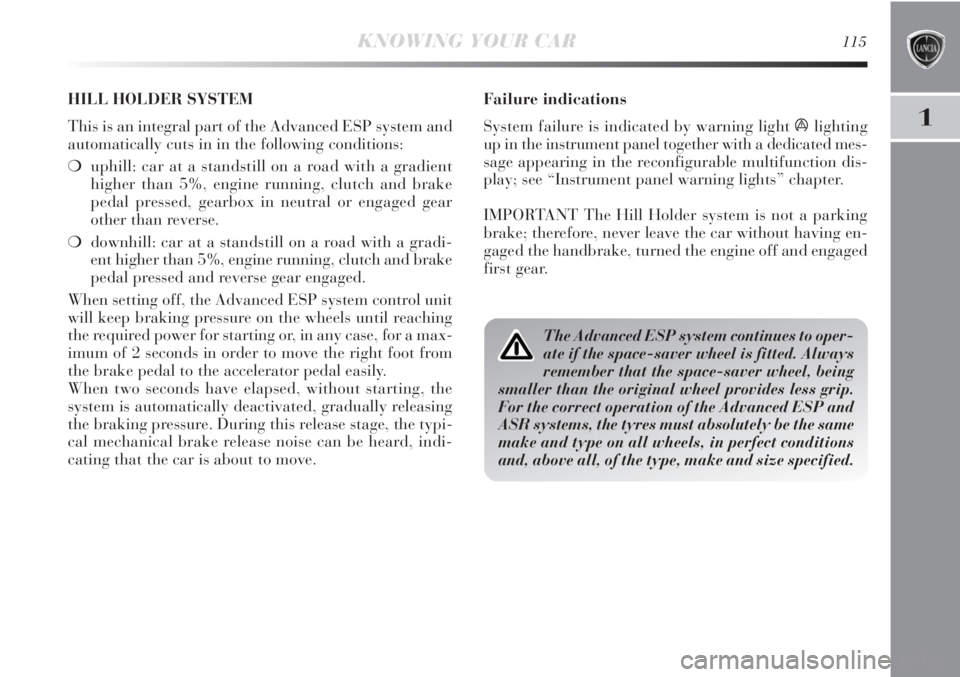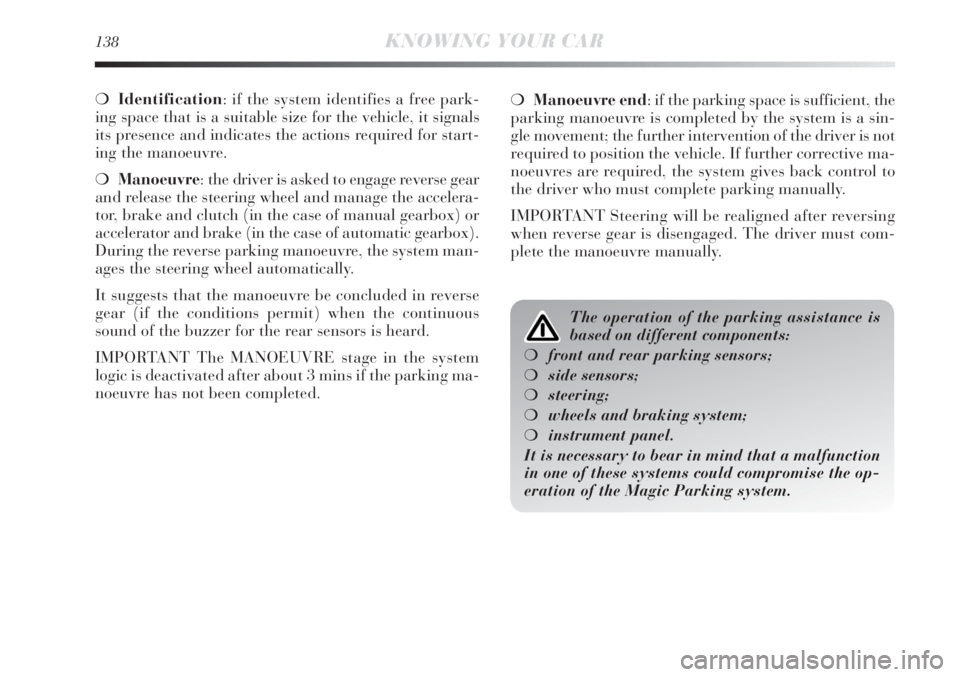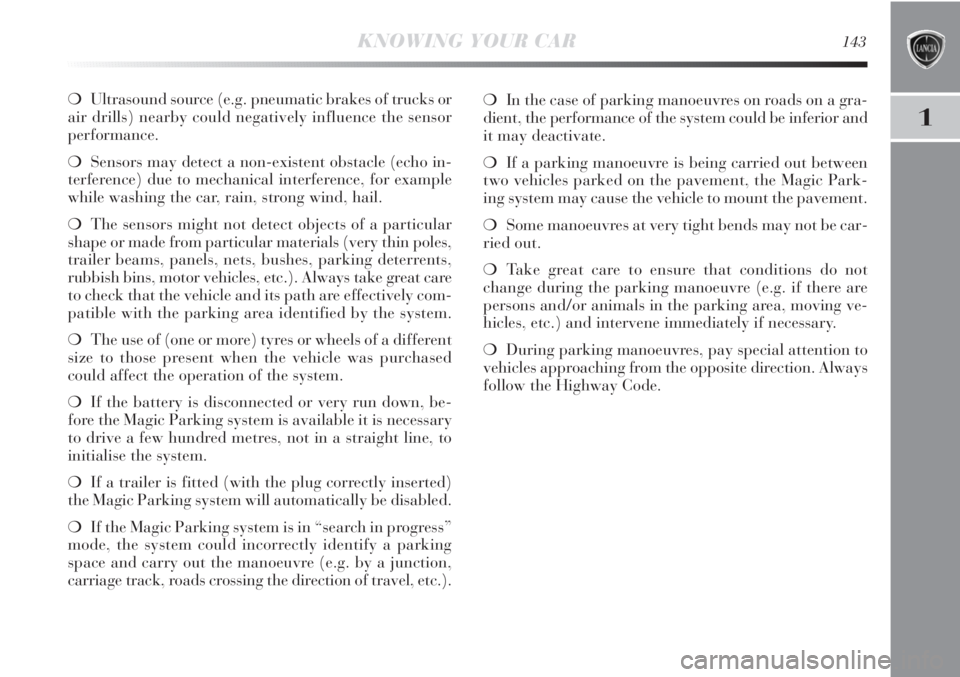wheel size Lancia Delta 2012 Owner handbook (in English)
[x] Cancel search | Manufacturer: LANCIA, Model Year: 2012, Model line: Delta, Model: Lancia Delta 2012Pages: 295, PDF Size: 8.29 MB
Page 117 of 295

1
KNOWING YOUR CAR115
Failure indications
System failure is indicated by warning light
álighting
up in the instrument panel together with a dedicated mes-
sage appearing in the reconfigurable multifunction dis-
play; see “Instrument panel warning lights” chapter.
IMPORTANT The Hill Holder system is not a parking
brake; therefore, never leave the car without having en-
gaged the handbrake, turned the engine off and engaged
first gear.
The Advanced ESP system continues to oper-
ate if the space-saver wheel is fitted. Always
remember that the space-saver wheel, being
smaller than the original wheel provides less grip.
For the correct operation of the Advanced ESP and
ASR systems, the tyres must absolutely be the same
make and type on all wheels, in perfect conditions
and, above all, of the type, make and size specified.
HILL HOLDER SYSTEM
This is an integral part of the Advanced ESP system and
automatically cuts in in the following conditions:
❍uphill: car at a standstill on a road with a gradient
higher than 5%, engine running, clutch and brake
pedal pressed, gearbox in neutral or engaged gear
other than reverse.
❍downhill: car at a standstill on a road with a gradi-
ent higher than 5%, engine running, clutch and brake
pedal pressed and reverse gear engaged.
When setting off, the Advanced ESP system control unit
will keep braking pressure on the wheels until reaching
the required power for starting or, in any case, for a max-
imum of 2 seconds in order to move the right foot from
the brake pedal to the accelerator pedal easily.
When two seconds have elapsed, without starting, the
system is automatically deactivated, gradually releasing
the braking pressure. During this release stage, the typi-
cal mechanical brake release noise can be heard, indi-
cating that the car is about to move.
Page 134 of 295

132KNOWING YOUR CAR
Contact
a Lancia Dealership
Repair the damaged
wheel
Contact
a Lancia Dealership
–
Contact
a Lancia Dealership
––
NO
NO
YES
YES
YESYES
YES
YES
NO
NO
NO
(*) Given as an alternative in the Owner Handbook and available at Lineaccessori Lancia.
(**) Not cross-swapped (tyres must stay on the same side).
In order to use the system properly, refer to the following table when you have to change wheels/tyres:
Operation Sensor Fault indication Lancia Authorized
Services intervention
–
Replacing a wheel
with the spare wheel
Replacing the wheels
with winter tyres
Replacing the wheels
with winter tyres
Replacing wheels
with others of a different size (*)
Switching wheels
(front/rear) (**)
Page 140 of 295

138KNOWING YOUR CAR
❍Identification: if the system identifies a free park-
ing space that is a suitable size for the vehicle, it signals
its presence and indicates the actions required for start-
ing the manoeuvre.
❍Manoeuvre: the driver is asked to engage reverse gear
and release the steering wheel and manage the accelera-
tor, brake and clutch (in the case of manual gearbox) or
accelerator and brake (in the case of automatic gearbox).
During the reverse parking manoeuvre, the system man-
ages the steering wheel automatically.
It suggests that the manoeuvre be concluded in reverse
gear (if the conditions permit) when the continuous
sound of the buzzer for the rear sensors is heard.
IMPORTANT The MANOEUVRE stage in the system
logic is deactivated after about 3 mins if the parking ma-
noeuvre has not been completed.❍Manoeuvre end: if the parking space is sufficient, the
parking manoeuvre is completed by the system is a sin-
gle movement; the further intervention of the driver is not
required to position the vehicle. If further corrective ma-
noeuvres are required, the system gives back control to
the driver who must complete parking manually.
IMPORTANT Steering will be realigned after reversing
when reverse gear is disengaged. The driver must com-
plete the manoeuvre manually.
The operation of the parking assistance is
based on different components:
❍front and rear parking sensors;
❍side sensors;
❍steering;
❍wheels and braking system;
❍instrument panel.
It is necessary to bear in mind that a malfunction
in one of these systems could compromise the op-
eration of the Magic Parking system.
Page 144 of 295

142KNOWING YOUR CAR
If the driver carries out a voluntary or involuntary action
on the steering during the parking manoeuvre (touch-
ing it or preventing its movement), the manoeuvre will
be interrupted.
If the road surface is very uneven or there are obstacles
under the wheels affecting the movement of the vehicle,
preventing it from continuing along the correct trajectory,
the manoeuvre may be interrupted.
Manoeuvre end
If the size of parking space permits, the parking ma-
noeuvre may be performed in one go; when reverse gear
is released the wheels will be realigned and the manoeu-
vre will be considered completed; the system will conse-
quently be deactivated. If the size of the parking space is
smaller, it may take several manoeuvres, the driver will
be advised to complete the parking manoeuvre manually
via a dedicated messages in the instrument panel display.General warnings
❍The ultimate responsibility when parking, however,
always rests with the driver. During these manoeuvres,
always make sure that no people, animals or objects are
within the manoeuvring area. The Magic Parking sys-
tem (like parking sensors) is designed to assist drivers: in
all cases, you must always pay the utmost attention dur-
ing potentially dangerous manoeuvres, even when these
are carried out a low speed:
❍If the sensors undergo shocks influencing their posi-
tion, the system operation could be strongly degraded.
❍If the sensors are dirty, covered by snow, ice or mud
or are repainted compared to the original conditions, the
system operation could be strongly degraded.
❍It is extremely important, for the correct operation of
the system, that the sensors are always kept clean. Dur-
ing cleaning make sure not to scratch or damage them;
avoid using dry or rough cloths. The sensors should be
washed using clean water with the addition of car sham-
poo if necessary. When using special washing equipment
such as high pressure jets or steam cleaning, clean the
sensors very quickly keeping the jet more than 10 cm
away.
If you wish to stop the steering wheel with
your hands during a manoeuvre, it is
advisable to handle it firmly on the outer
rim. Do not try and keep your hands on the inside
or hold the spokes.
Page 145 of 295

1
KNOWING YOUR CAR143
❍Ultrasound source (e.g. pneumatic brakes of trucks or
air drills) nearby could negatively influence the sensor
performance.
❍Sensors may detect a non-existent obstacle (echo in-
terference) due to mechanical interference, for example
while washing the car, rain, strong wind, hail.
❍The sensors might not detect objects of a particular
shape or made from particular materials (very thin poles,
trailer beams, panels, nets, bushes, parking deterrents,
rubbish bins, motor vehicles, etc.). Always take great care
to check that the vehicle and its path are effectively com-
patible with the parking area identified by the system.
❍The use of (one or more) tyres or wheels of a different
size to those present when the vehicle was purchased
could affect the operation of the system.
❍If the battery is disconnected or very run down, be-
fore the Magic Parking system is available it is necessary
to drive a few hundred metres, not in a straight line, to
initialise the system.
❍If a trailer is fitted (with the plug correctly inserted)
the Magic Parking system will automatically be disabled.
❍If the Magic Parking system is in “search in progress”
mode, the system could incorrectly identify a parking
space and carry out the manoeuvre (e.g. by a junction,
carriage track, roads crossing the direction of travel, etc.).❍In the case of parking manoeuvres on roads on a gra-
dient, the performance of the system could be inferior and
it may deactivate.
❍If a parking manoeuvre is being carried out between
two vehicles parked on the pavement, the Magic Park-
ing system may cause the vehicle to mount the pavement.
❍Some manoeuvres at very tight bends may not be car-
ried out.
❍Take great care to ensure that conditions do not
change during the parking manoeuvre (e.g. if there are
persons and/or animals in the parking area, moving ve-
hicles, etc.) and intervene immediately if necessary.
❍During parking manoeuvres, pay special attention to
vehicles approaching from the opposite direction. Always
follow the Highway Code.
Page 188 of 295

186STARTING AND DRIVING
IMPORTANT When snow tyres are used with a maxi-
mum speed index below the one that can be reached by
the car (increased by 5%), place a notice in the passen-
ger compartment, plainly in view, which states the max-
imum permissible speed of the snow tyres (as per an EC
Directive).
All four tyres should be the same (brand and track) to en-
sure greater safety when driving and braking and better
driveability.
Remember that it is inappropriate to change the rotation
direction of tyres.
The max. speed of snow tyres with “Q”
marking is 160 km/h. The Highway Code
speed limits must however be always com-
plied with.
SNOW TYRES
Use snow tyres of the same size as the normal tyres pro-
vided with the car.
A Lancia Dealership will be happy to provide advice con-
cerning the most suitable type of tyre for your require-
ments.
For the type of snow tyre to fit, the inflation pressures and
specifications, follow the instructions in the “Wheels”
paragraph in chapter “6” very carefully. The winter fea-
tures of these tyres are reduced considerably when the
tread depth is below 4 mm. Replace them in this case.
Due to snow tyre features, under normal conditions of use
or on long motorway journeys, the performance of these
tyres is much lower than that of standard tyres. Their us-
age should therefore be restricted in accordance with to
their type approval.
Page 201 of 295

IN AN EMERGENCY199
4
REPLACING A WHEEL
GENERAL INSTRUCTIONS
The car may be originally fitted with a space-saver wheel
(for versions/markets, where provided).
Wheel changing and correct use of the jack and spare
wheel call for some precautions as listed below.
The space-saver wheel (for versions/mar kets
where provided) is specific to your car, do not
use it on other models, or use the spare wheel
of other models on your car. The space-saver wheel
must only be used in case of emergency. Never use
it for more than strictly necessary and never exceed
80 km/h. On the space-saver wheel there is an or-
ange label, summarising the main warnings re-
garding space-saver wheel usage restrictions.
Never remove or cover the label. Never ap-
ply a hub cup on a space-saver wheel. The
following information is provided in four
languages on the label: IMPORTANT! FOR TEM-
PORARY USE ONLY! 80 KM/H MAX.! REPLACE
WITH STANDARD WHEEL AS SOON AS POS-
SIBLE. DO NOT COVER THIS LABEL.
If you change the type of wheel (alloy rims instead
of steel rims) you will have to change the entire set
of fastening bolts with another set of suitably sized
bolts.
Alert other drivers that the car is stationary
in compliance with local regulations: haz-
ard warning lights, warning triangle, etc.
Any passengers on board should leave the car, es-
pecially if it is heavily laden. Passengers should
stay away from on-coming traffic while the wheel
is being changed. If parked on a slope or rough sur-
face, chock the wheels with wedges or other suit-
able devices.
Page 271 of 295

TECHNICAL SPECIFICATIONS269
6
7Jx16”- ET31
7Jx16”- ET31
7Jx17”- ET31
7,5Jx18”- ET35 (**)
4Bx15" H-ET 35 (*) 125/90 R15-96M (*)
(*) Depending on the trim level, the space-saver for the 1.9 Twin Turbo Multijet and the 2.0 Multijet has a 205/55 R16-91V tyre
and a 7Jx16"-ET31 rim. In this case the 205/55 R16 91V tyre has the same specifications as the space-saver: the information
in “Replacing a wheel” therefore refers to the 205/55 R16 91V tyre.
(**) For versions/markets, where provided.
(
❏) Tyre to which chains cannot be fitted.
(
■) 1.6 Multijet 115HP, 1.6 Multijet 120HP and 2.0 Multijet versions.
195/155R16-91V (■)
205/55 R16-91V
225/45 R17-91W
225/40 R18-92W
(❏)(**)
195/55R16-91T (■) (M+S)
205/55 R16-91T (M+S)
225/45 R17-91T (M+S)
225/40 R18-92T (M+S)
On 205/55 R16-91V tyres, use reduced size snow chains with a maximum projection of 9 mm beyond
the tyre profile. On 225/45 R17-91W tyres, use reduced size snow chains with a maximum projec-
tion of 7 mm beyond the tyre profile.
IMPORTANT Special techniques need to be adopted for 225/40 R18 92W tyres. For this reason, this tyre can only
be ordered when the car is purchased. Do not fit this tyre after the vehicle has been purchased!
Versions Rims Tyres Snow tyres Space-saver
(for versions/markets, where provided)
Rim Tyre
1.4 Turbo Jet
1.4 Turbo
Multi Air
1.6 Multijet
1.9 Twin
Turbo Multijet
2.0 Multijet
Page 272 of 295

205/55 R16-91V
125/90 R15-96
195/55 R16-91VXL
205/55 R16-91V
225/45 R17-91W
225/40 R18-92W2.7 2.5
2.7 2.5
2.7/2.8 (*) 2.5
2.9/3.1 (*) 2.7
270TECHNICAL SPECIFICATIONS
2.4 2.2
2.4 2.2
2.4 2.2
2.6 2.4
Add +0.3 bar to the prescribed pressure when the tyres are warm. Check correct pressure on a cold tyre.
With snow tyres, add +0.2 bar to the inflation pressure value prescribed for standard tyres.
When travelling at speeds over 160 km/h, inflate the tyres to the values specified for fully laden conditions.
The TPMS is not fitted with 195/55 R16 91V tyres.
COLD TYRE PRESSURES (bar)
2.2
4.2
SPACE-SAVER/SPARE WHEEL
Size Inflation pressure
Size STANDARD TYRES
Medium load Full load
Front Rear Front Rear
(*) 1.9 Twin Turbo Multijet and 2.0 Multijet versions